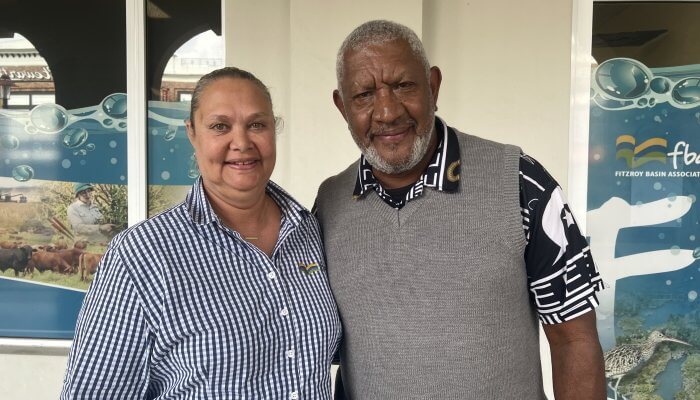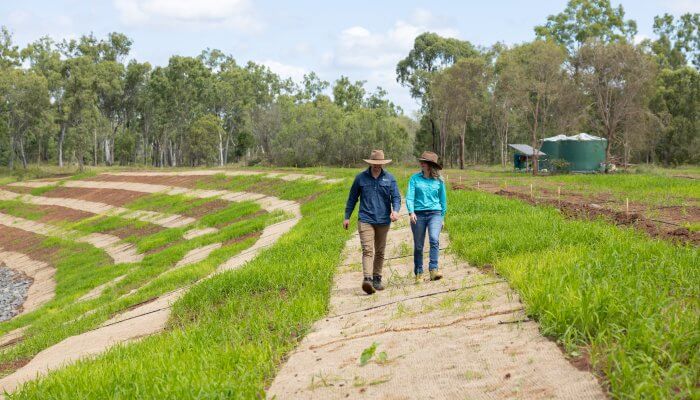
Planning 2024 and Shaping FBA’s future
Posted on February 1st, 2024
With 2024 now well underway FBA staff have been busy planning for the year ahead and kick starting some major projects.
Alongside our usual work, assisting graziers and growers to improve their land and empowering the community to protect the region’s natural assets, FBA staff have been developing a few key plans that will help shape the organisation going into the future.

Building relationships with First Nations Peoples
FBA’s Indigenous Participation Plan is being developed by our Indigenous Engagement Coordinator Gloria Malone.
The plan aims to increase participation of the region’s First Nations peoples in the work of FBA and in the management of the region’s cultural and natural management resources.
Gloria is a descendant of the Darumbal people on her mother and grandfather’s side of the family. Her father is of Western Kangulu and Wangan and Jangaulou (Clermont Belyando) descent, and her grandmother on her mother’s side who is of Karingbal and Ghungalou descent.
Gloria said the plan was important for FBA to offer structure on how the organisation can engage and work with First Nations people.
“The plan is really about building on FBA’s existing knowledge and relationships with First Nations people so we can continue to work together,” Gloria said.

“Part of the plan is around appropriately communicating with First Nations people.
“You don’t just walk into an Aboriginal community and talk business straight away. You build some rapport and trust first.
“It’s never just about business, it’s about getting to know that genuine person and that’s what we need to bring out through the plan.”
Gloria said part of the plan would see her helping connect landholders who engage with FBA, with local mob.
“I help make that connection so we can work together.”
Building Resilience in our Natural Assets
FBA is also developing an Emergency Preparedness Plan, focused on building the resilience of natural assets in the region to ensure they best survive natural disasters.
The Fitzroy Region boasts diverse landscapes, industries and communities and is home to approximately 242,500 people.
It is also home to some very special places and species, and adjoins the southern part of Australia’s iconic World Heritage Area – the Great Barrier Reef.
Agriculture is the major land use, up to 85 per cent of the landscape is used to produce food and fibre. Local grazing and farming enterprises are worth $1.2 billion annually to Queensland’s economy.
It features extensive natural assets, from mountain ranges, native grasslands, Brigalow forests and internationally significant wetlands all teeming with wildlife, some only found in this part of the world.
FBA Acting Environmental Accounts Coordinator Hannah Kaluzynski said it’s with this in mind that there is a growing need to enhance our preparedness and improve our response to natural disasters. The impact on biodiversity and agricultural natural capital assets is significant.
“Ensuring the survival of species and places helps to preserve key ecosystem services such as clean air, water, and climate regulation, all of which profoundly affect human well-being.
“Disaster preparedness bolsters the resilience of ecosystems, enabling them to recover and flourish following catastrophic events.”
FBA Acting Environmental Accounts Coordinator Hannah Kaluzynski said.
The Emergency Preparedness Plan considers the most likely disaster scenarios for the Fitzroy.
The plan will be built on the lessons learned during the 2019-20 Black Summer bushfires, other recent environmental disasters and on FBA’s current regional planning documents and networks across the region.
Encouraging Community to Care for our Environment
FBA is also working to develop a plan on how to best work with the community to encourage and empower them to care for our natural assets.
Acting Partnerships Leader Daniel Rea said the Community Participation Plan is a commitment from FBA on how it will work with the community to improve natural resource management over the next five years.
“We’re planning on doing things a little differently over the next five years to understand the community better and to find ways to increase our reach,” Daniel said.
“We’ll be trying to get more feedback from different community groups as to how we’re going and what they need to be able to contribute their own time to stewardship.”




















